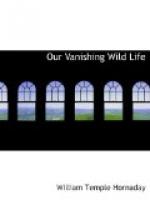THE FOX PEST IN AUSTRALIA.—And now unfortunate Australia has a new pest, also acquired by importation of an alien species. It is the European fox (Vulpes vulpes). The only redeeming feature about this fresh calamity is found in the fact that the species was not deliberately introduced into Australia for the benefit of the local fauna. Mr. O.W. Rosenhain, of Melbourne, informs me (1912) that about thirty years ago the Hunt Club brought to Australia about twenty foxes, for the promotion of the noble sport of fox hunting. In some untoward manner, the most of those animals escaped. They survived, multiplied, and have provided New South Wales, Victoria and South Australia with a fox pest of the first rank.
The destruction of wild bird life and poultry has become so serious that Australia now is making vigorous efforts to exterminate the pest. The government pays ten shillings bounty on fox scalps, besides which each prime fox skin is worth from four to five dollars. It is hoped that these combined values will eliminate the fox pest.
Regarding foxes in Australia, Mr. W.H.D. Le Souef has this to say in his extremely interesting and valuable book, “Wild Life in Australia,” page 146:
“We found that foxes were unfortunately plentiful in this district, and in a hollow log that served to shelter some cubs were noticed the remains of ducks, fowls, rabbits, lambs, bandicoots and snakes; so they evidently vary their fare, snakes even not coming amiss. They also sneak on wild ducks that are nesting by the edge of the water among the rushes and tussocky grass, and catch quail also, especially sitting birds. These animals are, and always will be, a great source of trouble in the thickly timbered country and stony ranges, and will gradually, like the rabbit, extend all over Australia. They are evidently not contented with ground game only, as Mr. A.F. Kelly, of Barwonleigh, in Victoria, states: “When riding past a bull-oak tree about twenty-five feet high, with either a magpie’s or crow’s nest on top. I noticed the nest looked very bulky, and had something red in it. On going nearer I saw a large fox coiled up in it!”
THE MONGOOSE.—Circumstances alter cases, and a change of environment sometimes works marvelous changes in the character of an animal species. Now, why should not the gray Indian mongoose (formerly called the ichneumon, (Herpestes griscus)) destroy poultry in India, as it does elsewhere? There is poultry in plenty to be destroyed, but “Rikki-Tikki-Tavi” elects to specialize on the killing of rats, and cobras, and other snakes.
In his own sphere of influence,—India and the orient,—the mongoose is a fairly decent citizen, and he fits into the time-worn economy of that region. As a destroyer of the thrice-anathema domestic rat, he has no equal in the domain of flesh and blood. His temper is so fierce that one “pet” mongoose has been known to kill a full grown male giant bustard, and put a greyhound to flight.




